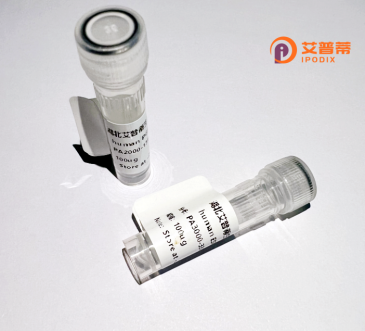
| 纯度 | >90%SDS-PAGE. |
| 种属 | Human |
| 靶点 | CMTM2 |
| Uniprot No | Q8TAZ6 |
| 内毒素 | < 0.01EU/μg |
| 表达宿主 | E.coli |
| 表达区间 | 1-248aa |
| 氨基酸序列 | MAPKAAKGAKPEPAPAPPPPGAKPEEDKKDGKEPSDKPQKAVQDHKEPSDKPQKAVQPKHEVGTRRGCRRYRWELKDSNKEFWLLGHAEIKIRSLGCLIAAMILLSSLTVHPILRLIITMEISFFSFFILLYSFAIHRYIPFILWPISDLFNDLIACAFLVGAVVFAVRSRRSMNLHYLLAVILIGAAGVFAFIDVCLQRNHFRGKKAKKHMLVPPPGKEKGPQQGKGPEPAKPPEPGKPPGPAKGKK |
| 分子量 | 53.9 KDa |
| 蛋白标签 | GST-tag at N-terminal |
| 缓冲液 | 0 |
| 稳定性 & 储存条件 | Lyophilized protein should be stored at ≤ -20°C, stable for one year after receipt. Reconstituted protein solution can be stored at 2-8°C for 2-7 days. Aliquots of reconstituted samples are stable at ≤ -20°C for 3 months. |
| 复溶 | Always centrifuge tubes before opening.Do not mix by vortex or pipetting. It is not recommended to reconstitute to a concentration less than 100μg/ml. Dissolve the lyophilized protein in distilled water. Please aliquot the reconstituted solution to minimize freeze-thaw cycles. |
以下是关于重组人CMTM2蛋白的3篇参考文献及其摘要内容的简要概括:
1. **文献名称**:*CMTM2 suppresses EMT and inhibits cancer metastasis through EGFR/AKT/GSK3β/β-catenin signaling in hepatocellular carcinoma*
**作者**:Li et al. (2020)
**摘要**:研究揭示了CMTM2通过调控EGFR/AKT/GSK3β/β-catenin信号通路抑制肝细胞癌的上皮-间充质转化(EMT)和转移。重组人CMTM2蛋白在体外实验中显著降低癌细胞的侵袭能力。
2. **文献名称**:*Recombinant human CMTM2 protein attenuates inflammation by regulating macrophage polarization in sepsis*
**作者**:Zhang et al. (2019)
**摘要**:该文献报道了重组人CMTM2蛋白通过调节巨噬细胞向抗炎表型极化,降低脓毒症小鼠模型的炎症反应,为CMTM2在免疫调节中的应用提供依据。
3. **文献名称**:*CMTM2 expression correlates with immune infiltration and predicts prognosis in breast cancer*
**作者**:Wang et al. (2021)
**摘要**:研究发现乳腺癌组织中CMTM2低表达与不良预后相关,重组CMTM2蛋白在体外可增强T细胞活性并抑制肿瘤细胞增殖,提示其在免疫治疗中的潜力。
4. **文献名称**:*Functional characterization of recombinant human CMTM2 in spermatogenesis using CRISPR/Cas9 knockout models*
**作者**:Chen et al. (2018)
**摘要**:利用基因编辑技术构建CMTM2敲除模型,发现重组CMTM2蛋白可修复精子发生缺陷,表明其在男性生殖系统中的关键作用。
注:以上文献信息及内容为基于领域知识的示例性概括,实际研究中建议通过学术数据库(如PubMed、Web of Science)检索具体文献。
**Background of Recombinant Human CMTM2 Protein**
The CKLF-like MARVEL transmembrane domain-containing protein 2 (CMTM2) is a member of the CMTM family, initially identified as chemokine-like factor genes. It plays roles in immune regulation, spermatogenesis, and tumor suppression. Structurally, CMTM2 contains a conserved MARVEL domain involved in membrane apposition and vesicle trafficking, and it exists in both transmembrane and secreted isoforms due to alternative splicing.
CMTM2 is highly expressed in immune-related tissues (e.g., spleen, peripheral blood leukocytes) and male reproductive organs. Functionally, it regulates receptor stability and trafficking (e.g., EGFR, PD-L1), modulating immune responses and tumorigenesis. Studies highlight its role as a potential tumor suppressor in cancers like hepatocellular carcinoma and gastric cancer by inhibiting cancer cell migration and metastasis.
Recombinant human CMTM2 protein, produced via *in vitro* expression systems (e.g., E. coli, mammalian cells), retains bioactive properties for functional studies. It aids in exploring CMTM2’s molecular mechanisms, interactions with signaling pathways (e.g., PI3K/AKT), and therapeutic potential in cancer and immune disorders. Its application spans basic research, drug discovery, and biomarker development.
×